View this article in another language
- 한국어
- English
- 日本語
- 中文
- العربية
- Español
- Français
- Deutsch
- Pусский
- Tiếng Việt
- Indonesian
*This is the eighth part in our series, “Gat, traditional headgear in Korea.”
The designation and transmission of gannil
1. The Chongmoja-jang
The chongmoja is the crown of the gat and is made of horsehair. The crown was originally only produced in the town of Tongyeong, but was later also made on Jeju Island. Jeju is known for its horses and so horsehair, the main material for the hat, was more easily obtained there.
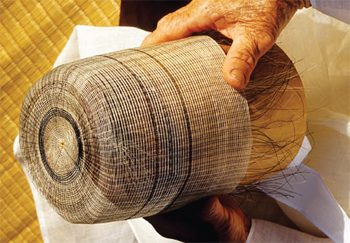 Go Jae-gu of Tongyeong was designated in 1964 as a first generation skill-holder, or a chongmoja-jang. In 1967, there were several active female artisans, centering on Dodu-ri on Jeju Island, who could weave the crown, including Yeom In-ja. After Go's death, there were no more crown makers on the mainland. Oh Song-juk on Jeju Island was recognized as a skill-holder in 1980. When Oh passed away in 1984, Kim In became a skill-holder. At present, no one on mainland Korea has the ability to make the crown of the hat and the weaving skills and techniques are only transmitted on Jeju Island.
Go Jae-gu of Tongyeong was designated in 1964 as a first generation skill-holder, or a chongmoja-jang. In 1967, there were several active female artisans, centering on Dodu-ri on Jeju Island, who could weave the crown, including Yeom In-ja. After Go's death, there were no more crown makers on the mainland. Oh Song-juk on Jeju Island was recognized as a skill-holder in 1980. When Oh passed away in 1984, Kim In became a skill-holder. At present, no one on mainland Korea has the ability to make the crown of the hat and the weaving skills and techniques are only transmitted on Jeju Island.
The first chongmoja-jang, Go Jae-gu (1897-1979), was from Tongyeong and was renowned for his outstanding skills of weaving horsehair and cow tail, materials used for Tongyeong-style gat in his time. At the age of 15, the young Go entered into the chongmoja workshop run by Gwon Myeong-sik and started to learn the techniques amid 100 skilled artisans. As an apprentice, he was given the task of weaving the crown tip first and then the side band of the crown. Also, he had to acquire golbaegi, the skill of evenly adjusting warp and weft spacing after boiling the newly woven crown, called a saengjjabaeki or an unboiled crown. The task is known as kkaenda on the mainland.
After Korea's independence from Japanese colonial rule, he was responsible for warp and weft spacing at a gat workshop run by Jeon Deok-gi and Kim Bong -ju in Tongyeong. In his spare time, he made crowns by himself at his cottage in order to make a living. It is said that because of his exquisite skill, it took him five days at the most to weave the upper part of the gat.
Thanks to distinct regional characteristics, Jeju Island has become the center of horse breeding in Korea. Horsehair produced on the island has facilitated the birth of horsehair crafts, including the weaving of the tanggeon, or headgear, and of the manggeon, or headband. Specifically, this is the reason that Jeju is home to many artisans who make the gat crown. The number of crown artisans significantly declined in the 1960s. It was discovered in 1967 that Yeom In-ja (b. 1902), the oldest among the chongmoja-jangs in the town of Dodu-ri, was still weaving crowns. She had been making crowns, mostly during the agricultural off season, since she was seven years old. At around the age of 23 she began weaving the tanggeon and the brim of the gat. However, her specialty was still making the crown.
Kang Won-im (b. 1907) and Mun Gi-saeng also learned the skills of making the crown at the age of seven or eight and kept weaving the crown of the hat during the agricultural off season as they grew older. This shows that many people were involved in making the crown in the Dodu-ri area, the western part of northern Jeju County, on Jeju Island. In additional, a folk song that people used to sing while weaving the crown has been handed down in Aewol-eup, which demonstrated that the work of making the crown was also popular in that region. Since 1970, the crown has been produced mainly in Bangdi, Oei-do, Dodu-ri, Ora-ri and Molraemol, all on Jeju Island.
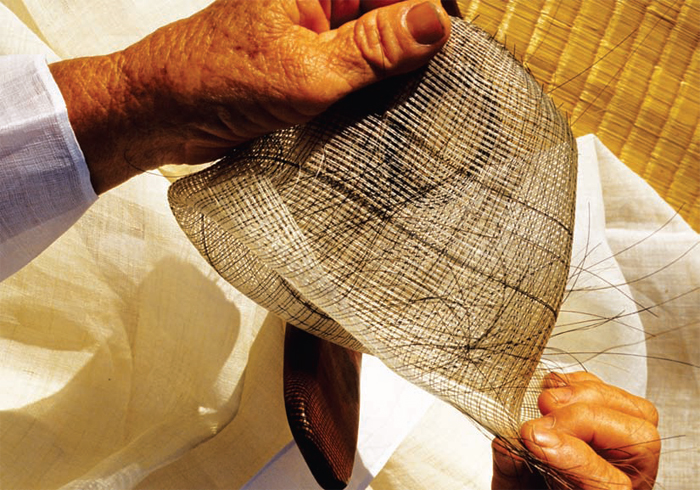
Oh Song-juk (1940-1983) began to produce gat crowns at the age of 10 while residing in Dodu-ri. Around 1980, having no family, she lived with Kim In to make Kim In's niece and daughter-in-law her apprentices. As a result, Kim Yeong-ja and Kim Chae-ok were designated as scholarship apprentices in July 1981.
Kim In (b. 1920) was born to a family involved in farming and fishing in Dodu-dong, Jeju City. She worked as a diver in her youth. By the early 1970s, she was producing the crown in her home. As she lived together with Oh Song-juk, a first generation skill-holder, she started to learn the weaving techniques again and resumed weaving crowns in earnest for many years, fully equipped with tools and materials. As a result, she was recognized as a chongmoja-jang of gannil, and was designated as Important Cultural Heritage Item No. 4 on February 1, 1985. Later, she transmitted her skills to her daughter, Kang Sun-ja (b. 1946), who had worked as a teaching assistant and was then designated as a skill-holder in September 2009 when her teacher and mother, Kim In, became an honorary skill-holder. Kang Sun-ja's daughter, Yang Yun-hee, as an apprentice graduate, sat at her grandmother Kim In's feet.
The yangtae-jang
A yangtae-jang is an artisan who specializes in making the brim of the gat by using bamboo strips as thin as a thread. In the 1960s, these skill-holders mostly resided around Chungmu and Geoje in South Gyeongsang Province. In 1967, a considerable number of female yangtae makers were discovered in Whabuk, Sinchon and Waheul, as well as in Samyang, on the eastern side of Jeju Island.
Among male artisans in the Tongyeong area, Mo Man-hwan was selected as a first generation yangtae-jang and as an Important Intangible Cultural Heritage Item. Since 1971, when Mo passed away, brim makers have not been found on the mainland. Based on a 1967 survey, Go Jeong-saeng of Jeju Island succeeded Mo and served as a skill-holder in the 1980s. At present, the traditional skills and techniques of making a gat brim are kept only by brim skill-holders on Jeju Island.
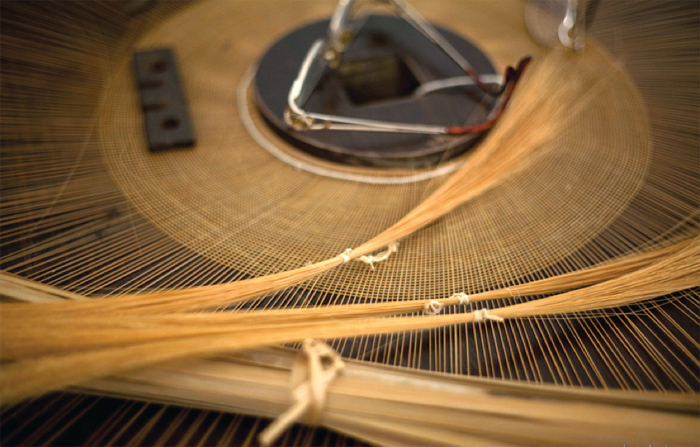
The earlier yangtae-jang, Je Hak-jin (b. 1880), was born to a family that had been engaged in gat-making since his great-grandfather's time. He also worked in making the brim of the gat in Misu, Chungmu City, South Gyeongsang Province. When he was eight years old, the young Je was taught the skills of brim-making from his uncle, Je Mun-won, who was 40 years older than Je and was at that time a famous artisan. From that time onward, Je Hak-jin was involved in traditional hat making for approximately 70 years. As he aged, he stopped working.
Mo Man-hwan (1887-1971) carried out the yangtae business in Geoje County, South Gyeongsang Province, but he originally came from Chungmu City. He was ten years old when he started to learn how to make the brim. His maternal uncle, Go Deok-yun, who was 50 years older than him, lived together with his family and made brims. From then on, he continued the job for some 70 years.
Mo Man-hwan was capable of making the brim of a jinsalip, a king of gat worn by aristocrats. The jinsalip's brim is made by first chopping a piece of bamboo with long joints. A cut is made at the joints and the bamboo is split lengthwise into finger-width strips. The strips are boiled and then soaked in water for 15 days to smooth the grain, because bamboo is tough. A bamboo sheath is peeled with a knife after its inside has been scraped out. Then it is rubbed against a piece of leather laid across the knee.
The bamboo sheath, as thin as a piece of paper, is placed on the thick bamboo and cut into thin pieces at one end with a small, sharp knife. Each piece is shredded along the grain by hand to make a strand. In order to make sure the bamboo strands have the same thickness, they are passed through the joreumdae, a device with a piece of perforated iron attached to a block of wood. Finally, the bamboo strands are made. A thicker strand is used to the warp and the finest ones are for the weft and the bitdae, the diagonally laid bamboo strands.
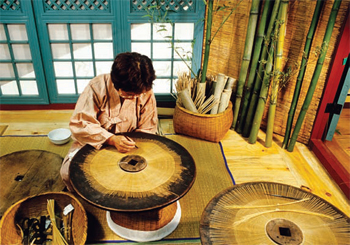
Mo Man-hwan's brim is said to have been made with 150 wefts of bamboo thread and a finer one with 200 wefts. At his peak, he could make one brim in 10 days.
On Jeju Island, the brim making business was a fairly good source of income, which significantly benefited the family economy. The brim was made in large quantities in Whabuk, Sinchon and Waheul, centering on Samyang, all on Jeju Island, where many brim makers resided.
The 1967 survey shows that there were brim makers in Samyang, including Jang Gap-saeng (b. 1903) and Yeom Mu-saeng (b. 1908). According to the 1980 records, Kim Nan-saeng (b. 1909) and Han Mun-ok (b. 1905), along with Go Jeong-saeng, were still alive as brim artisans at that time. Kim Nan-saeng, who used to be a diver, had long woven the tanggeon and the crown of the gat, as well as the brim. Han Mun-ok was also considered a skillful brim maker in the Samyang area.
Go Jeong-saeng (1904-1980) was born in Doyeon, Jeju City, a place where brim making has long been common. She lived in Jocheon District, North Jeju County. At the age of eight, she began to learn the skill of making the brim from her mother, Kang Gun-il. Since the brim was in high demand by the time of Korean independence, brim makers were short-handed. Those who were nimble and dexterous enough were highly recognized at that time. Thanks to her mother, Go Jeong-saeng was able to acquire a highly skillful technique, making a brim in two days at most by the age of ten. From the age of 15, she was known as a good yangtae-jang and even took special orders for brims.
In the days when Go Jeong-saeng wove the brim, each village had a yangtae-cheong, a communal workshop in which five to six people gathered to make the brim together. She said, "When I was young, we gathered in the yangtae-cheong to weave the brim competitively." This traditional work had a great deal of influence on the lives of Jeju women and their family economy. Samyang and Jocheon in the eastern part of Jeju Island were famous producers of gat brims because those areas are geographically closer to Jocheon Port and to Hwabuk Port, both of which served as portals to Jeju Island. Every single household in Samyang village was engaged in making the brim, which became a staple product in the traditional village markets held at five-day intervals. Bamboo, the main material of the brim, was imported in large quantities to Samyang from Hadong, Jinju and Damyang. Wholesale dealers of the traditional hat supplied bamboo to Jeju and collected the finished brim products to take them to gat workshops in various regions, including Chungmu.
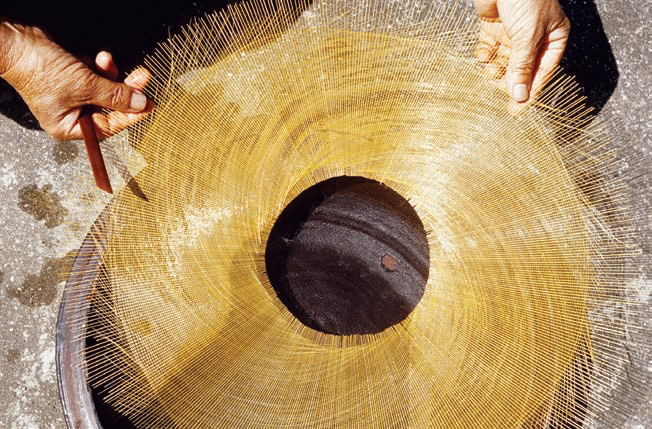
The ordinance prohibiting topknots brought about a sharp decline in demand for the brim. However, demand skyrocketed on the occasions of the national funerals for King Gojong in 1919 and King Sunjong in 1926. Since all ordinary people had to wear a baekrip, or a white gat, during the national mourning period, brim makers produced coarse brims for the mourners in large quantities, thus earning a lot of money.
Before Korea's independence from Japanese colonial rule, the horsehair hat was in great demand. A brim artisan earned more than a diver on Jeju Island, which made the occupation quite popular. Thanks to her long, nimble fingers, Go Jeong-saeng could weave a finer and more delicate brim than other hat makers. During periods of peak demand, from August to November, she made brims ordered by merchants from the mainland who had paid in advance.
Demand for the brim dropped dramatically after the Korean War (1950-1953), resulting in Go Jeong-saeng taking only a few orders a year. It is common that most brim makers lose their sight in their 50s and can no longer weave. However, she was able to make a brim as fine as a spider web even when she was over 70 years old. In November 1980, at the age of 70, she was designated as a skill-holder and as an Important Intangible Cultural Heritage Item. Her outstanding skills were handed down intact to her youngest daughter, Jang Sun-ja.
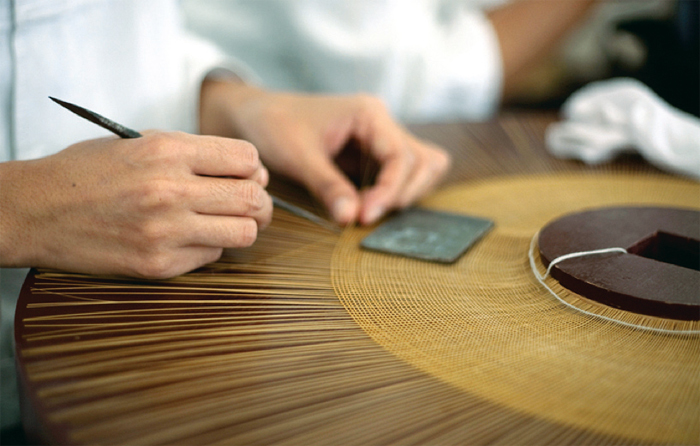
Jang Sun-ja (b. 1940) has taken up a career as a third generation yangtae-jang, following in the footsteps of her maternal grandmother Kang Sun-il and her mother Go Jeong-saeng. As far as Jang remembers, her mother, Go, dedicated her life to weaving brims. For example, she never let go of either the yangtae-making board or her basket of tools and materials, and she continued weaving even when a problem arose in the family or while visiting neighbors. Her skills were said to be superb.
Jang, who was born in Myeonchon, Doryeon Neighborhood, Jeju City, worked in the bamboo business and supplied bamboo to brim artisans across Jeju Island for 10 years, starting at the age of 23 at her mother's suggestion. When she turned 43, her mother was designated as a skill-holder and as an Intangible Cultural Heritage Item by the Korean government. Then, she began in earnest to learn the skills associated with making gat brims.
In 2000, Jang was designated as a second generation yangtae-jang, succeeding her mother. This appointment resulted in Jang quitting her tangerine farm and becoming fully occupied with learning the skills of brim making, while staying with her mother. Just as her mother had done, Jang began passing down her yangtae-making skills to her daughter, Yang Jeong-mi, who was then a third year college student. The four generations of her family have devoted themselves to preserving the traditional skills of brim making.
A folk song about the brim used to be popular in several places on Jeju Island, proving that Jeju is the home of the brim and brim artisans. The production of gat brims had a great influence on the economic life of Jeju's women. Gat dealers, such as Choi Sang-gen and Jang Jae-geun, collected and purchased crowns and brims at the five-day markets on Jeju Island and then sold them on the mainland. Since the 1970s, however, when demand for the traditional hat declined, ipja-jang Park Chang-yeong has personally visited Jeju Island to purchase or make orders for either the crown or the brim of a gat.
*This series of article has been made possible through the cooperation of the National Research Institute of Cultural Heritage. (Source: Intangible Cultural Heritage of Korea)
The designation and transmission of gannil
1. The Chongmoja-jang
The chongmoja is the crown of the gat and is made of horsehair. The crown was originally only produced in the town of Tongyeong, but was later also made on Jeju Island. Jeju is known for its horses and so horsehair, the main material for the hat, was more easily obtained there.

The first chongmoja-jang, Go Jae-gu (1897-1979), was from Tongyeong and was renowned for his outstanding skills of weaving horsehair and cow tail, materials used for Tongyeong-style gat in his time. At the age of 15, the young Go entered into the chongmoja workshop run by Gwon Myeong-sik and started to learn the techniques amid 100 skilled artisans. As an apprentice, he was given the task of weaving the crown tip first and then the side band of the crown. Also, he had to acquire golbaegi, the skill of evenly adjusting warp and weft spacing after boiling the newly woven crown, called a saengjjabaeki or an unboiled crown. The task is known as kkaenda on the mainland.
After Korea's independence from Japanese colonial rule, he was responsible for warp and weft spacing at a gat workshop run by Jeon Deok-gi and Kim Bong -ju in Tongyeong. In his spare time, he made crowns by himself at his cottage in order to make a living. It is said that because of his exquisite skill, it took him five days at the most to weave the upper part of the gat.
Thanks to distinct regional characteristics, Jeju Island has become the center of horse breeding in Korea. Horsehair produced on the island has facilitated the birth of horsehair crafts, including the weaving of the tanggeon, or headgear, and of the manggeon, or headband. Specifically, this is the reason that Jeju is home to many artisans who make the gat crown. The number of crown artisans significantly declined in the 1960s. It was discovered in 1967 that Yeom In-ja (b. 1902), the oldest among the chongmoja-jangs in the town of Dodu-ri, was still weaving crowns. She had been making crowns, mostly during the agricultural off season, since she was seven years old. At around the age of 23 she began weaving the tanggeon and the brim of the gat. However, her specialty was still making the crown.
Kang Won-im (b. 1907) and Mun Gi-saeng also learned the skills of making the crown at the age of seven or eight and kept weaving the crown of the hat during the agricultural off season as they grew older. This shows that many people were involved in making the crown in the Dodu-ri area, the western part of northern Jeju County, on Jeju Island. In additional, a folk song that people used to sing while weaving the crown has been handed down in Aewol-eup, which demonstrated that the work of making the crown was also popular in that region. Since 1970, the crown has been produced mainly in Bangdi, Oei-do, Dodu-ri, Ora-ri and Molraemol, all on Jeju Island.

Oh Song-juk (1940-1983) began to produce gat crowns at the age of 10 while residing in Dodu-ri. Around 1980, having no family, she lived with Kim In to make Kim In's niece and daughter-in-law her apprentices. As a result, Kim Yeong-ja and Kim Chae-ok were designated as scholarship apprentices in July 1981.
Kim In (b. 1920) was born to a family involved in farming and fishing in Dodu-dong, Jeju City. She worked as a diver in her youth. By the early 1970s, she was producing the crown in her home. As she lived together with Oh Song-juk, a first generation skill-holder, she started to learn the weaving techniques again and resumed weaving crowns in earnest for many years, fully equipped with tools and materials. As a result, she was recognized as a chongmoja-jang of gannil, and was designated as Important Cultural Heritage Item No. 4 on February 1, 1985. Later, she transmitted her skills to her daughter, Kang Sun-ja (b. 1946), who had worked as a teaching assistant and was then designated as a skill-holder in September 2009 when her teacher and mother, Kim In, became an honorary skill-holder. Kang Sun-ja's daughter, Yang Yun-hee, as an apprentice graduate, sat at her grandmother Kim In's feet.
The yangtae-jang
A yangtae-jang is an artisan who specializes in making the brim of the gat by using bamboo strips as thin as a thread. In the 1960s, these skill-holders mostly resided around Chungmu and Geoje in South Gyeongsang Province. In 1967, a considerable number of female yangtae makers were discovered in Whabuk, Sinchon and Waheul, as well as in Samyang, on the eastern side of Jeju Island.
Among male artisans in the Tongyeong area, Mo Man-hwan was selected as a first generation yangtae-jang and as an Important Intangible Cultural Heritage Item. Since 1971, when Mo passed away, brim makers have not been found on the mainland. Based on a 1967 survey, Go Jeong-saeng of Jeju Island succeeded Mo and served as a skill-holder in the 1980s. At present, the traditional skills and techniques of making a gat brim are kept only by brim skill-holders on Jeju Island.

The earlier yangtae-jang, Je Hak-jin (b. 1880), was born to a family that had been engaged in gat-making since his great-grandfather's time. He also worked in making the brim of the gat in Misu, Chungmu City, South Gyeongsang Province. When he was eight years old, the young Je was taught the skills of brim-making from his uncle, Je Mun-won, who was 40 years older than Je and was at that time a famous artisan. From that time onward, Je Hak-jin was involved in traditional hat making for approximately 70 years. As he aged, he stopped working.
Mo Man-hwan (1887-1971) carried out the yangtae business in Geoje County, South Gyeongsang Province, but he originally came from Chungmu City. He was ten years old when he started to learn how to make the brim. His maternal uncle, Go Deok-yun, who was 50 years older than him, lived together with his family and made brims. From then on, he continued the job for some 70 years.
Mo Man-hwan was capable of making the brim of a jinsalip, a king of gat worn by aristocrats. The jinsalip's brim is made by first chopping a piece of bamboo with long joints. A cut is made at the joints and the bamboo is split lengthwise into finger-width strips. The strips are boiled and then soaked in water for 15 days to smooth the grain, because bamboo is tough. A bamboo sheath is peeled with a knife after its inside has been scraped out. Then it is rubbed against a piece of leather laid across the knee.
The bamboo sheath, as thin as a piece of paper, is placed on the thick bamboo and cut into thin pieces at one end with a small, sharp knife. Each piece is shredded along the grain by hand to make a strand. In order to make sure the bamboo strands have the same thickness, they are passed through the joreumdae, a device with a piece of perforated iron attached to a block of wood. Finally, the bamboo strands are made. A thicker strand is used to the warp and the finest ones are for the weft and the bitdae, the diagonally laid bamboo strands.

Mo Man-hwan's brim is said to have been made with 150 wefts of bamboo thread and a finer one with 200 wefts. At his peak, he could make one brim in 10 days.
On Jeju Island, the brim making business was a fairly good source of income, which significantly benefited the family economy. The brim was made in large quantities in Whabuk, Sinchon and Waheul, centering on Samyang, all on Jeju Island, where many brim makers resided.
The 1967 survey shows that there were brim makers in Samyang, including Jang Gap-saeng (b. 1903) and Yeom Mu-saeng (b. 1908). According to the 1980 records, Kim Nan-saeng (b. 1909) and Han Mun-ok (b. 1905), along with Go Jeong-saeng, were still alive as brim artisans at that time. Kim Nan-saeng, who used to be a diver, had long woven the tanggeon and the crown of the gat, as well as the brim. Han Mun-ok was also considered a skillful brim maker in the Samyang area.
Go Jeong-saeng (1904-1980) was born in Doyeon, Jeju City, a place where brim making has long been common. She lived in Jocheon District, North Jeju County. At the age of eight, she began to learn the skill of making the brim from her mother, Kang Gun-il. Since the brim was in high demand by the time of Korean independence, brim makers were short-handed. Those who were nimble and dexterous enough were highly recognized at that time. Thanks to her mother, Go Jeong-saeng was able to acquire a highly skillful technique, making a brim in two days at most by the age of ten. From the age of 15, she was known as a good yangtae-jang and even took special orders for brims.
In the days when Go Jeong-saeng wove the brim, each village had a yangtae-cheong, a communal workshop in which five to six people gathered to make the brim together. She said, "When I was young, we gathered in the yangtae-cheong to weave the brim competitively." This traditional work had a great deal of influence on the lives of Jeju women and their family economy. Samyang and Jocheon in the eastern part of Jeju Island were famous producers of gat brims because those areas are geographically closer to Jocheon Port and to Hwabuk Port, both of which served as portals to Jeju Island. Every single household in Samyang village was engaged in making the brim, which became a staple product in the traditional village markets held at five-day intervals. Bamboo, the main material of the brim, was imported in large quantities to Samyang from Hadong, Jinju and Damyang. Wholesale dealers of the traditional hat supplied bamboo to Jeju and collected the finished brim products to take them to gat workshops in various regions, including Chungmu.

The ordinance prohibiting topknots brought about a sharp decline in demand for the brim. However, demand skyrocketed on the occasions of the national funerals for King Gojong in 1919 and King Sunjong in 1926. Since all ordinary people had to wear a baekrip, or a white gat, during the national mourning period, brim makers produced coarse brims for the mourners in large quantities, thus earning a lot of money.
Before Korea's independence from Japanese colonial rule, the horsehair hat was in great demand. A brim artisan earned more than a diver on Jeju Island, which made the occupation quite popular. Thanks to her long, nimble fingers, Go Jeong-saeng could weave a finer and more delicate brim than other hat makers. During periods of peak demand, from August to November, she made brims ordered by merchants from the mainland who had paid in advance.
Demand for the brim dropped dramatically after the Korean War (1950-1953), resulting in Go Jeong-saeng taking only a few orders a year. It is common that most brim makers lose their sight in their 50s and can no longer weave. However, she was able to make a brim as fine as a spider web even when she was over 70 years old. In November 1980, at the age of 70, she was designated as a skill-holder and as an Important Intangible Cultural Heritage Item. Her outstanding skills were handed down intact to her youngest daughter, Jang Sun-ja.

Jang Sun-ja (b. 1940) has taken up a career as a third generation yangtae-jang, following in the footsteps of her maternal grandmother Kang Sun-il and her mother Go Jeong-saeng. As far as Jang remembers, her mother, Go, dedicated her life to weaving brims. For example, she never let go of either the yangtae-making board or her basket of tools and materials, and she continued weaving even when a problem arose in the family or while visiting neighbors. Her skills were said to be superb.
Jang, who was born in Myeonchon, Doryeon Neighborhood, Jeju City, worked in the bamboo business and supplied bamboo to brim artisans across Jeju Island for 10 years, starting at the age of 23 at her mother's suggestion. When she turned 43, her mother was designated as a skill-holder and as an Intangible Cultural Heritage Item by the Korean government. Then, she began in earnest to learn the skills associated with making gat brims.
In 2000, Jang was designated as a second generation yangtae-jang, succeeding her mother. This appointment resulted in Jang quitting her tangerine farm and becoming fully occupied with learning the skills of brim making, while staying with her mother. Just as her mother had done, Jang began passing down her yangtae-making skills to her daughter, Yang Jeong-mi, who was then a third year college student. The four generations of her family have devoted themselves to preserving the traditional skills of brim making.
A folk song about the brim used to be popular in several places on Jeju Island, proving that Jeju is the home of the brim and brim artisans. The production of gat brims had a great influence on the economic life of Jeju's women. Gat dealers, such as Choi Sang-gen and Jang Jae-geun, collected and purchased crowns and brims at the five-day markets on Jeju Island and then sold them on the mainland. Since the 1970s, however, when demand for the traditional hat declined, ipja-jang Park Chang-yeong has personally visited Jeju Island to purchase or make orders for either the crown or the brim of a gat.
*This series of article has been made possible through the cooperation of the National Research Institute of Cultural Heritage. (Source: Intangible Cultural Heritage of Korea)
![Gat, traditional headgear in Korea [7]](/upload/content/image/1395108155289.jpg)
![Gat, traditional headgear in Korea [6]](/upload/content/image/1393924045608.jpg)
![Gat, traditional headgear in Korea [5]](/upload/content/image/1393319340768.jpg)
![Gat, traditional headgear in Korea [4]](/upload/content/image/1392690825210.jpg)
![Gat, traditional headgear in Korea [3]](/upload/content/image/1392095636707.jpg)
![Gat, traditional headgear in Korea [2]](/upload/content/image/1391590339998.jpg)
